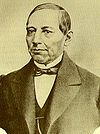| Revision as of 02:01, 9 November 2005 edit201.135.93.22 (talk) →Attractions← Previous edit | Revision as of 02:10, 9 November 2005 edit undo201.135.93.22 (talk) →AttractionsNext edit → | ||
| Line 15: | Line 15: | ||
| Malls: Las Misiones, Plaza Las Torres, Rio Grande Mall, Plaza Juarez Mall, and coming soon Galerias Tec. | Malls: Las Misiones, Plaza Las Torres, Rio Grande Mall, Plaza Juarez Mall, and coming soon Galerias Tec. | ||
| Movie theaters: Cinepolis |
Movie theaters: Cinemark, Cinepolis, MM Cinemas, & Multicinemas. | ||
| Parks: EL Chamizal and Parque Central. | Parks: EL Chamizal and Parque Central. | ||
Revision as of 02:10, 9 November 2005

Ciudad Juárez (also known simply as Juárez) (2000 population 1,142,354) is a city in the Mexican state of Chihuahua. It stands on the Rio Grande (Río Bravo), across the U.S. border from El Paso, Texas. It is the major port of entry and transportation center of north central Mexico and the fifth largest city in the country. It is a growing industrial center, with numerous maquiladoras (assembly plants).
Juárez was founded as El Paso del Norte ("the Northern Pass") in 1659 by Spanish explorers, seeking a route through the southern Rocky Mountains. The 1848 Treaty of Guadalupe Hidalgo established the Rio Grande as the border between Mexico and the United States, separating the settlements on the north bank of the river from the rest of the town.

During the French intervention in Mexico (1862–1867), El Paso del Norte served as a temporary capital of Benito Juárez's republican forces. In 1888, El Paso del Norte was renamed in honor of Juárez.

Juárez again served as a provisional Mexican capital during the initial phase of the Mexican Revolution, when forces loyal to opposition candidate Francisco I. Madero, led by Pancho Villa, seized the city on 20 November 1910. The scene of intense fighting for a decade, Juárez recovered during the United States Prohibition era (1919–1933) as an entertainment center. Juárez continued to attract tourists from the southwest USA during the 1940s and 1950s, with its bars, nightclubs, brothels, bullfighting, and shopping.
Juárez has grown substantially in recent decades, and now has extensive areas of slum housing. Juárez has gained further notoriety as a major center of narcotics trafficking, and for several hundred unsolved murders of young women since the early 1990s.
Attractions
Malls: Las Misiones, Plaza Las Torres, Rio Grande Mall, Plaza Juarez Mall, and coming soon Galerias Tec.
Movie theaters: Cinemark, Cinepolis, MM Cinemas, & Multicinemas.
Parks: EL Chamizal and Parque Central.